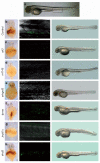New gene functions in megakaryopoiesis and platelet formation
- PMID: 22139419
- PMCID: PMC3335296
- DOI: 10.1038/nature10659
New gene functions in megakaryopoiesis and platelet formation
Abstract
Platelets are the second most abundant cell type in blood and are essential for maintaining haemostasis. Their count and volume are tightly controlled within narrow physiological ranges, but there is only limited understanding of the molecular processes controlling both traits. Here we carried out a high-powered meta-analysis of genome-wide association studies (GWAS) in up to 66,867 individuals of European ancestry, followed by extensive biological and functional assessment. We identified 68 genomic loci reliably associated with platelet count and volume mapping to established and putative novel regulators of megakaryopoiesis and platelet formation. These genes show megakaryocyte-specific gene expression patterns and extensive network connectivity. Using gene silencing in Danio rerio and Drosophila melanogaster, we identified 11 of the genes as novel regulators of blood cell formation. Taken together, our findings advance understanding of novel gene functions controlling fate-determining events during megakaryopoiesis and platelet formation, providing a new example of successful translation of GWAS to function.
Figures


References
-
- Devlin B, Roeder K. Genomic control for association studies. Biometrics. 1999;55:997–1004. - PubMed
Publication types
MeSH terms
Substances
Grants and funding
- K12 RR023250/RR/NCRR NIH HHS/United States
- R01 HL086694/HL/NHLBI NIH HHS/United States
- P01 HL076491/HL/NHLBI NIH HHS/United States
- G0601966/MRC_/Medical Research Council/United Kingdom
- R01 HL105756/HL/NHLBI NIH HHS/United States
- P30 DK072488/DK/NIDDK NIH HHS/United States
- G0701863/MRC_/Medical Research Council/United Kingdom
- U01 HL072515/HL/NHLBI NIH HHS/United States
- N01 HC055021/HC/NHLBI NIH HHS/United States
- WT077047/Z/05/Z/WT_/Wellcome Trust/United Kingdom
- R01 HL088119/HL/NHLBI NIH HHS/United States
- ETM/55/CSO_/Chief Scientist Office/United Kingdom
- CZB/4/505/CSO_/Chief Scientist Office/United Kingdom
- N01 HC055022/HC/NHLBI NIH HHS/United States
- RG/09/012/28096/BHF_/British Heart Foundation/United Kingdom
- G0801056/MRC_/Medical Research Council/United Kingdom
- UL1 RR025005/RR/NCRR NIH HHS/United States
- WT077037/Z/05/Z/WT_/Wellcome Trust/United Kingdom
- R01 HL087679/HL/NHLBI NIH HHS/United States
- R01 HL068986/HL/NHLBI NIH HHS/United States
- R01 HL059367/HL/NHLBI NIH HHS/United States
- G0700931/MRC_/Medical Research Council/United Kingdom
- R01 HL085251/HL/NHLBI NIH HHS/United States
- 092731/WT_/Wellcome Trust/United Kingdom
- N01 HC055018/HC/NHLBI NIH HHS/United States
- R01 HD042157/HD/NICHD NIH HHS/United States
- I 434/FWF_/Austrian Science Fund FWF/Austria
- R01 HL103866/HL/NHLBI NIH HHS/United States
- G1000143/MRC_/Medical Research Council/United Kingdom
- G0000111/MRC_/Medical Research Council/United Kingdom
- WT082597/Z/07/Z/WT_/Wellcome Trust/United Kingdom
- MC_U106179471/MRC_/Medical Research Council/United Kingdom
- U01 HL084756/HL/NHLBI NIH HHS/United States
- N01 HC055019/HC/NHLBI NIH HHS/United States
- P41 HG003751/HG/NHGRI NIH HHS/United States
- P01 HL098055/HL/NHLBI NIH HHS/United States
- G0701120/MRC_/Medical Research Council/United Kingdom
- G0401527/MRC_/Medical Research Council/United Kingdom
- M01 RR016500/RR/NCRR NIH HHS/United States
- N01 HC055015/HC/NHLBI NIH HHS/United States
- G0700704/MRC_/Medical Research Council/United Kingdom
- MC_U105260799/MRC_/Medical Research Council/United Kingdom
- N01 HC055020/HC/NHLBI NIH HHS/United States
- BB/F019394/1/BB_/Biotechnology and Biological Sciences Research Council/United Kingdom
- RL1 MH083268/MH/NIMH NIH HHS/United States
- N01 HC085079/HC/NHLBI NIH HHS/United States
- R01 GM053275/GM/NIGMS NIH HHS/United States
- R01 HL087641/HL/NHLBI NIH HHS/United States
- R01 HL073410/HL/NHLBI NIH HHS/United States
- MC_U106188470/MRC_/Medical Research Council/United Kingdom
- 098051/WT_/Wellcome Trust/United Kingdom
- R01 AG018728/AG/NIA NIH HHS/United States
- U01 GM074518/GM/NIGMS NIH HHS/United States
- U54 RR020278/RR/NCRR NIH HHS/United States
- N01 HC055016/HC/NHLBI NIH HHS/United States
LinkOut - more resources
Full Text Sources
Other Literature Sources
Molecular Biology Databases

